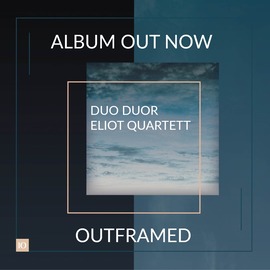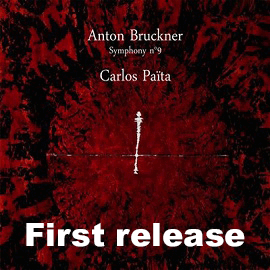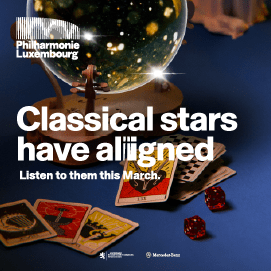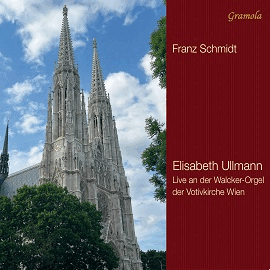Das Album Bridges to Infinity bei Solo Musica beinhaltet ein Violinkonzert, ein Bratschenkonzert, sowie die 8. Symphonie für Sopran, Chor und Orchester.
The Birds – Wisdom & Magic beginnt archaisch im Schöpfungsakt. Es beschwört dann – nach den Prinzipien der mystischen Alchemie – die magische Welt der Vögel, rhythmisch und düster die Raben und Krähen, lyrisch der Schwan, flatterhaft der Pfau, ritualtänzerisch die Kraniche.
Der Solist Friedemann Eichhorn und die Bodensee Philharmonie unter der Leitung von Gabriel Venzago machen mit einer engagierten und spannenden, sehr farbigen Interpretation dieses Stück zu einem nachhaltig wirkungsvollen Werk, das sich dem Hörer einprägt.
Fatal Harmonies ist ein Viola-Konzert, « das die dramatische Zerrissenheit und die musikalische Radikalität des Renaissance-Komponisten Carlo Gesualdo thematisiert. » Alexia Eichhorn spielt intensiv und technisch brillant, stimmungsvoll begleitet von der Bodensee Philharmonie.
Enjott Schneiders klangmalerische Achte Symphonie, Die Glocke, für Sopran, Chor und Orchester stellt Glockenklänge in den Mittelpunkt. Der erste der sechs Sätze ist chinesisch gefärbt. Darauf folgt ein zunächst ruhiger und melancholischer Satz, der schließlich mit orientalischen Rhythmen tänzerisch abhebt, ehe die Sopranistin zum Zuge kommt. Der rein instrumentale dritte Satz, Klang der Götter, Schrecken der Dämonen, ist kontrastreich und rhythmisch. Danach folgt eine ebenfalls nur vom Orchester präsentierte, schillernde ind feierliche Hommage an William Byrd. Das Gedicht ‘Sehnsucht’ von Otto Julius Bierbaum führt unmittelbar zum Thema zurück: « Wie eine leise Glocke klingt
Die Sehnsucht in mir an », und diese Glocke geht höchst symbolkräftig! – im Lärm unter. Die Musik ist hell, nordisch gefärbt, und nostalgisch. Der letzte Satz, Dona nobis Pacem beginnt kraftvoll, opulent, mit einer ausdrucksstarken Dynamik und entwickelt sich mit einem lyrisch Mittelteil zu einem inbrünstig flehenden Schluss, in dem der Ruf nach Frieden mit Chorgesang, Glockenklang und Orchesterkraft immer eindringlicher wird. Der abrupte Schluss zeigt, dass dieser Frieden nicht erreicht wurde.
Die beiden Konzerte und die Symphonie zeigen Enjott Schneider erneut als phantasievollen und einfallsreichen Komponisten, dessen Werke sich durch eine Mischung aus Tradition und Modernität und oft auch außereuropäischen Einflüssen auszeichnen, einen gewissen cineastischen Einfluss nicht verheimlichen und entsprechend auf sehr zugängliche Weise musikalische Geschichten erzählen.
The album Bridges to Infinity on Solo Musica includes a violin concerto, a viola concerto and the 8th Symphony for soprano, choir and orchestra.
The Birds – Wisdom & Magic begins archaically in the act of creation. It then conjures up – according to the principles of mystical alchemy – the magical world of birds, rhythmically and sombrely the ravens and crows, lyrically the swan, flutteringly the peacock, ritualistically the cranes.
The soloist Friedemann Eichhorn and the Lake Constance Philharmonic Orchestra under the direction of Gabriel Venzago turn this piece into a lasting and impressive work with a committed and exciting, very colorful interpretation.
Fatal Harmonies is a viola concerto « that explores the dramatic conflict and musical radicalism of the Renaissance composer Carlo Gesualdo. » Alexia Eichhorn plays with intensity and technical brilliance, atmospherically accompanied by the Bodensee Philharmonie.
Enjott Schneider’s programmatic Eighth Symphony, Die Glocke, for soprano, choir and orchestra focuses on the sounds of bells. The first of the six movements is Chinese in color. This is followed by an initially calm and melancholy movement, which finally takes off in a dance-like manner with oriental rhythms before the soprano comes into her own. The purely instrumental third movement, Klang der Götter, Schrecken der Dämonen, is rich in contrast and rhythmic. This is followed by a dazzling and solemn homage to William Byrd, also performed solely by the orchestra. The poem ‘Sehnsucht’ (Longing) by Otto Julius Bierbaum leads directly back to the theme: « Like a soft bell rings
The longing in me », and this bell – highly symbolic! – is drowned in the noise. The music is bright, Nordic in color, and nostalgic. The last movement, Dona nobis Pacem, begins powerfully, opulently, with expressive dynamics and develops with a lyrical middle section to a fervently pleading conclusion, in which the call for peace becomes ever more insistent with choral singing, the sound of bells and orchestral power. The abrupt ending shows that this peace has not been achieved.
The two concertos and the symphony once again show Enjott Schneider as an imaginative and inventive composer whose works are characterized by a mixture of tradition and modernity and often also non-European influences, do not conceal a certain cinematic influence and accordingly tell musical stories in a very accessible way.






















